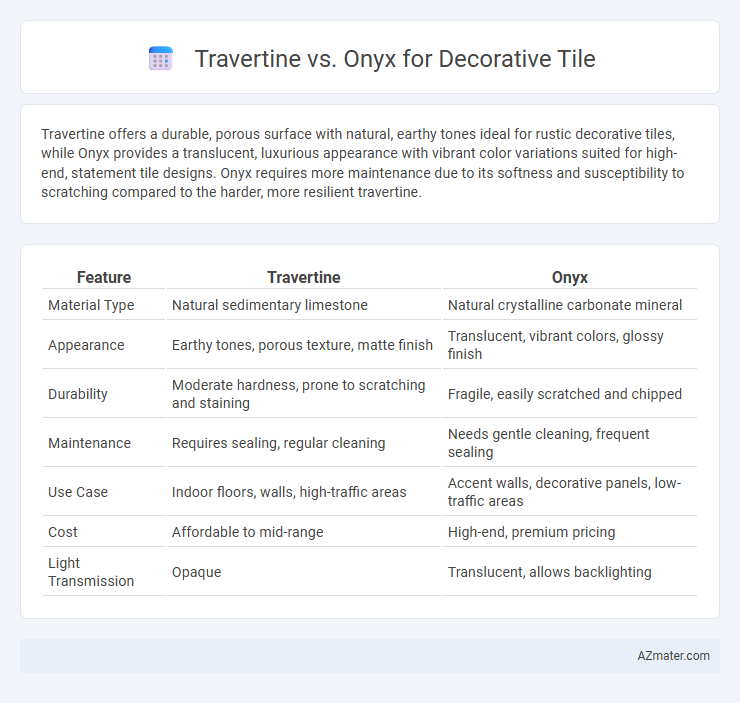Travertine offers a durable, porous surface with natural, earthy tones ideal for rustic decorative tiles, while Onyx provides a translucent, luxurious appearance with vibrant color variations suited for high-end, statement tile designs. Onyx requires more maintenance due to its softness and susceptibility to scratching compared to the harder, more resilient travertine.
Table of Comparison
| Feature | Travertine | Onyx |
|---|---|---|
| Material Type | Natural sedimentary limestone | Natural crystalline carbonate mineral |
| Appearance | Earthy tones, porous texture, matte finish | Translucent, vibrant colors, glossy finish |
| Durability | Moderate hardness, prone to scratching and staining | Fragile, easily scratched and chipped |
| Maintenance | Requires sealing, regular cleaning | Needs gentle cleaning, frequent sealing |
| Use Case | Indoor floors, walls, high-traffic areas | Accent walls, decorative panels, low-traffic areas |
| Cost | Affordable to mid-range | High-end, premium pricing |
| Light Transmission | Opaque | Translucent, allows backlighting |
Introduction to Travertine and Onyx Tiles
Travertine and onyx tiles are popular natural stone options for decorative applications, each offering distinct aesthetic and physical properties. Travertine features a porous, fibrous texture with earth-toned hues ranging from beige to rust, making it ideal for rustic, warm designs. Onyx tiles are prized for their translucency and vibrant veining patterns, often used in backlit installations to create dramatic visual effects in luxury interiors.
Unique Characteristics of Travertine Tiles
Travertine tiles are renowned for their distinctive porous surface, which creates a naturally textured appearance ideal for decorative applications. Their warm, earthy tones range from creamy beige to rich caramel, enhancing spaces with an organic, timeless elegance. Unlike onyx, travertine's durability and matte finish make it highly suitable for high-traffic areas while maintaining a unique rustic charm.
Distinctive Features of Onyx Tiles
Onyx tiles feature translucent qualities that create a luminous effect when backlit, setting them apart from the more opaque travertine. Their rich, swirling patterns and vibrant color variations, including amber, green, and honey tones, add a luxurious and dynamic aesthetic to decorative surfaces. Onyx is softer and more fragile than travertine, requiring careful handling and sealing to preserve its natural beauty in tile applications.
Appearance and Aesthetic Differences
Travertine offers a natural, earthy appearance with porous textures and warm, neutral tones, creating a rustic and classic aesthetic ideal for traditional and Mediterranean designs. Onyx features a translucent, glossy surface with dramatic veining and vibrant color variations, providing a luxurious and modern look that enhances light play and visual depth. The distinct differences in texture and translucency make travertine suitable for understated elegance, while onyx stands out as a striking centerpiece in decorative tile applications.
Durability and Longevity Comparison
Travertine offers superior durability with a hardness rating of 3 to 4 on the Mohs scale, making it resistant to scratches and ideal for high-traffic decorative tile applications. Onyx, rated at 3 on the Mohs scale, is softer and more prone to scratching and etching, requiring careful maintenance to preserve its translucency and aesthetic appeal. Both stones require sealing, but travertine typically provides longer-lasting performance and resilience in decorative tile use due to its denser composition.
Maintenance and Care Requirements
Travertine requires regular sealing to prevent staining and moisture damage, as its porous surface easily absorbs liquids and dirt, necessitating gentle cleaning with pH-neutral cleaners. Onyx, being softer and more delicate, demands careful maintenance to avoid scratches and etching, with immediate cleaning of spills and avoidance of acidic or abrasive substances crucial for preserving its polished surface. Both materials benefit from professional sealing and routine upkeep, but travertine generally withstands wear better, making it slightly easier to maintain for decorative tile applications.
Cost and Value Considerations
Travertine tiles typically cost between $3 to $7 per square foot, offering a durable and affordable option for decorative surfaces, while onyx tiles range from $15 to $40 per square foot due to their rarity and luxurious appearance. Travertine provides excellent long-term value with low maintenance and strength, making it ideal for high-traffic areas, whereas onyx delivers a unique translucency and dramatic aesthetic but requires careful upkeep and is less resistant to wear. Choosing between travertine and onyx depends on budget constraints and the desired balance between cost-efficiency and premium visual impact.
Popular Design Applications
Travertine tiles are favored in popular design applications such as flooring, bathroom walls, and kitchen backsplashes due to their natural, earthy tones and porous texture that adds warmth and rustic charm. Onyx tiles, prized for their translucent quality and vibrant veining, are frequently used in luxury interiors like feature walls, countertops, and backlit installations to create dramatic, elegant focal points. Both materials enhance decorative tile projects with unique visual appeal, but travertine is preferred for a classic, textured look while onyx suits modern, high-end designs with striking light effects.
Environmental Impact and Sustainability
Travertine, a natural limestone, has a lower environmental impact due to its widespread availability and minimal processing requirements compared to onyx, which is rarer and requires more intensive quarrying. Onyx mining often results in significant habitat disruption and higher carbon emissions from extraction and transportation. For sustainability, travertine's durability and recyclability make it a more eco-friendly choice in decorative tile applications.
Choosing Between Travertine and Onyx: Key Takeaways
Travertine offers durability and a natural, textured appearance ideal for high-traffic areas, while onyx features a translucent, luxurious aesthetic that suits accent walls and low-traffic spaces. Travertine's porous surface requires sealing to prevent stains, whereas onyx demands delicate handling due to its softness and higher cost. Selecting between travertine and onyx hinges on balancing budget, maintenance willingness, and the desired visual impact in decorative tile applications.

Infographic: Travertine vs Onyx for Decorative Tile
 azmater.com
azmater.com